PERIKLES (c. 490–429 BC) Ancient Greek politician, strategist...

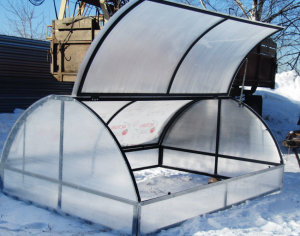
Now you can buy a ready-made greenhouse of any shape and size, and the owner, who knows how to hold tools in his hands, can build it in a matter of days, since there are a lot of standard projects. Particularly popular are greenhouses with a retractable roof or removable roof elements.
Often, when building with your own hands, questions arise: what form to make a structure, from what materials, how to cover it, which roof is better for a greenhouse? The answers depend on the way the building is placed, the size, wind and snow loads in the area. Next, we will review what types of roofs are most relevant, and we will give step by step instructions how to make a greenhouse with removable roof with your own hands.

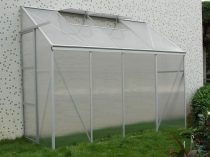
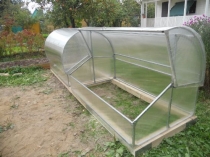
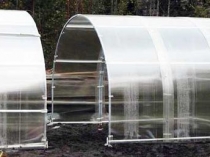
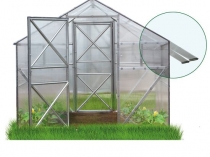
The design of the greenhouse mainly depends on the installation site, so if it is a freestanding structure, then an arched or gable roof is usually made, broken, spherical, pyramidal shapes are less common. For wall structures, it is advisable to choose single-pitched or curved, asymmetric.
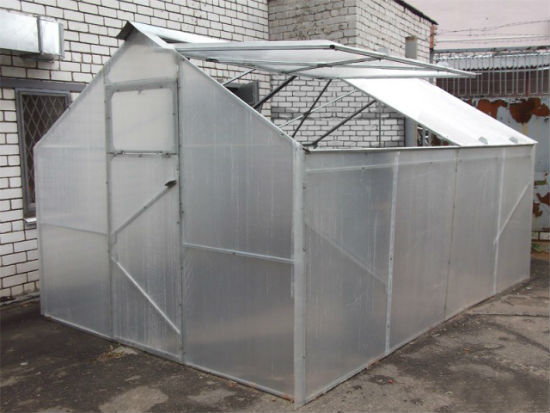
A folding roof for a polycarbonate greenhouse, which is a large window on the lifts, is also suitable for film buildings
The material of manufacture is also important, for example, it is quite difficult to make an arched frame from wood, it takes time and knowledge of technology, special templates and clamps, therefore, buildings on a wooden base are more often rectangular in shape under a single-pitched roof. It is easier to bend metal, especially if you have a pipe bender at hand, the service can be ordered at any hardware store, metal ones are often built with arched roofs, curved roofs and gable roofs are less common. If the base is made of pvc pipes, then it is better to stop at the arch. Glass buildings are possible only under a single-, double-pitched roof, but moving the elements is fraught with fragile glass, besides, the material is heavy, not very suitable for folding and sliding structures. Modern technologies make it possible to bend glass, but the process is expensive and not suitable for outbuildings.
See how gracefully the roof of the shed greenhouse went, a convenient and practical option.
Sometimes materials for construction are combined, they make a wooden base, which is crowned with a metal truss, or vice versa, a metal frame under a gable roof made of wood.
Roofs of complex shapes, including broken and curvilinear, are made extremely rarely, due to the complexity of manufacturing the truss system. It is better to take ready-made projects-drawings of a broken roof for a greenhouse, all loads and mating angles are calculated there, independent calculations are quite problematic.
For small greenhouses, folding roofs are relevant, usually lean-to. Now it has become popular to make opening roofs, usually 2 types:
For pitched greenhouses, the optimal angle of inclination is 15-45 o, more accurate parameters depend on calculations that are made based on wind and snow loads in your area. A flat roof is not recommended, as it is likely to sag from the weight of the snow.
Arched ones are considered the most suitable for all regions, they have excellent aerodynamic characteristics, it is practically not necessary to clean such structures from snow, it rolls off the sloping sides.
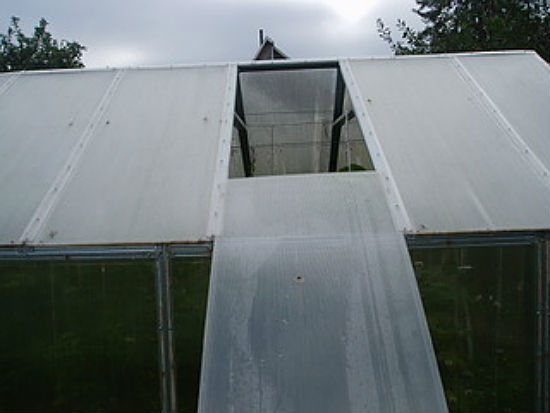
Sliding greenhouse roof
It is not difficult to make the simplest sliding roof, you will need a drawing of a polycarbonate greenhouse with a gable roof, only the joints of the sheets should not be made on thermal washers, but to arrange a groove system from a strip of polycarbonate.
In connection with the demand for structures, we will separately tell you what kind of greenhouses with an opening roof are. Device type:
In terms of functionality, open-top greenhouses also differ:
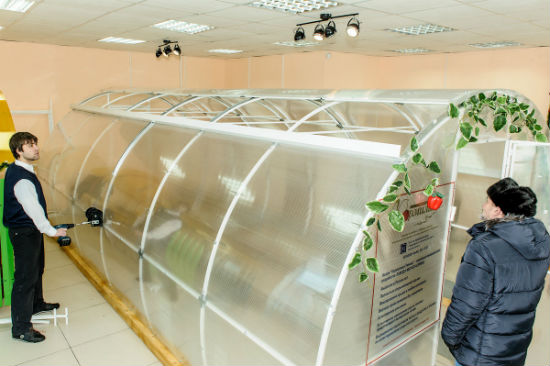
Partially retractable roof, convenient for ventilation
In fact, opening roofs for greenhouses can be divided into 2 large groups:
We offer a video about a collapsible greenhouse sliding along rails, the sections are assembled one on one like a nesting doll.
The rails can be straight, then the segments travel in a straight line, on top of each other, to the sides. Due to the high price, greenhouses with domed roofs are less common, here the rails are curved, in a circle, the segments move one on one.
Important: it is better to cover greenhouses with sliding roofs with polycarbonate, the material is strong, resistant to mechanical stress, the film can tear with frequent use. For hinged elements of greenhouses, it is equally advisable to use polycarbonate and film coating.In the issue of sliding structures, the drive is important - a power device that drives the system. For simple greenhouses, such a power unit is the owner, who opens the sections manually, using a winch, hoist, etc. simple mechanisms. If finances allow, then the best option is a greenhouse with an automatic sliding roof, this greatly facilitates work and saves time. If you install temperature sensors and relays, then the structure itself will open when the temperature rises and perform the reverse process when it gets cold.
Remember the joke: I'm like a convertible, everything is so cool, but there is no roof. A convertible greenhouse with a removable roof is indeed a very practical design, usually covered with polycarbonate. Finished products can be bought in different lengths, they are durable, not afraid of snow loads, you yourself understand: there is no roof - there are no problems either, snow gets inside the building through the opening, there are no side loads. You can make such a greenhouse with a removable roof with your own hands, here it is important to choose the right metal, usually a professional pipe 20 * 20 mm 25 * 20 mm, 40 * 20 mm, bend it, and fit a mechanism for pushing the sections apart. Among advanced gardeners, a convertible greenhouse with a removable roof has proven itself very well, reviews on the forums testify to the practicality, strength of the building and ease of use.
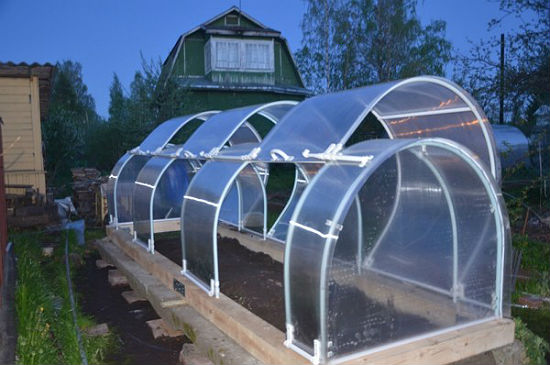
Greenhouse convertible - practical, reliable, economical, convenient
Watch a video about a greenhouse with a retractable roof, you can easily make such a transformer with your own hands.
Based on the overview of the opening roofs, it can be concluded that either the roof or a whole segment of the greenhouse moves along rails, or a part opens with a special lift. Both options are available when building a sliding roof greenhouse.
In fact, the rollback of segments is carried out according to the principle of conventional compartment doors. We make a solid base, we attach a rail to it, which is better to buy in a store. Separately, we make arched parts, from below we attach a metal bar to them, equipped with wheels for smooth running. It is recommended to install a stopper at the end of the rails so that the parts do not go beyond the plank.
Advice: If it is necessary that the segments go one on one, then the arcs must be of different diameters, from smaller to larger.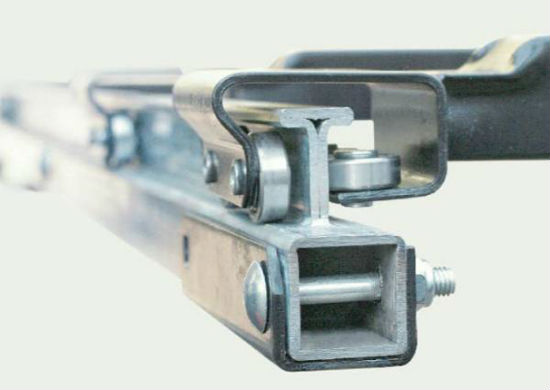
A mechanism that will help make sliding polycarbonate greenhouses
If you have a rectangular structure, then the rail mechanism can be installed on the upper trim and an arched sliding roof can already be mounted on it. In buildings under pitched roofs, sliding walls can be made, this device is again based on this device.
Sliding structures are very simple in execution and do not require the purchase of expensive elements. The principle of operation lies in the groove system, that is, special pockets should be made on the frame, along which a polycarbonate sheet will walk. This sliding principle is suitable for arched and pitched roofs.
The do-it-yourself sliding roof of a polycarbonate greenhouse is quite simple:
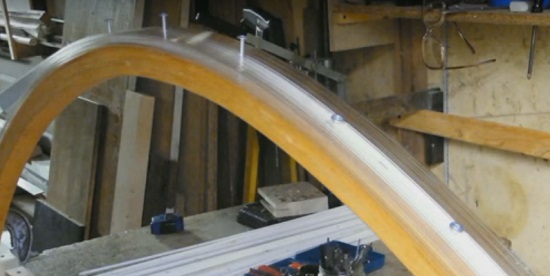
On household plots, as palaces for early vegetables, greenhouses with an opening roof are placed. Already on sale ready-made models of such buildings made of lightweight polycarbonate so there are plenty to choose from. It is important to decide on the area that you can give under the greenhouse, because you won’t have to dismantle it for the winter. Such buildings stand still for years and delight the owners with an early harvest, first of greens, and then of vegetables.

You can list ready-made models of greenhouses with an opening roof:
The designs of these greenhouses are somewhat similar, the removable or movable roof during the heat allows you to perfectly ventilate the premises, and in winter it does not collect snow on itself and does not squeeze through, even if there are heavy snowfalls. The roof sashes can be easily moved, tilted or dismantled.
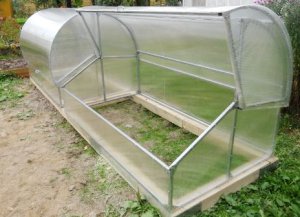
For the construction of light greenhouses most commonly used reliable polycarbonate. A large open-top greenhouse will easily accommodate all the seedlings that you have so painstakingly grown at home. The entire structure of the polycarbonate greenhouse with durable aluminum risers and removable roof doors in a collapsible state takes up so little space that you can easily transport it to the dacha.
The weight of the greenhouse, depending on the model, varies from 2 kg to 100 kg. It all depends on the size of the building. For a small area, the smallest polycarbonate greenhouse is useful, because on six acres you want not only to grow a rich harvest, but also to lay out a lawn and flower beds.
A good polycarbonate greenhouse is a real hostess-breadwinner for the whole family, in a well-groomed room from early spring, radishes and greens will delight you, and if you plan the usable area correctly, then a greenhouse with an opening roof can bring two to three crops of greenery during the growing season.
A little financial help will not hurt anyone, you can grow dill and parsley for sale. Public catering establishments, mostly small cafes, are happy to buy fresh herbs from private producers, because they are always beautiful and fragrant.
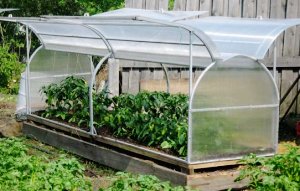
It remains only to choose a greenhouse model - with gable roof so that the snow itself rolls off the surface in winter or still with removable individual sheets. Of course, so that there are no worries, you can limit yourself to a ready-made vented design. It is quite enough to ventilate such holes in the walls of the greenhouse, given that there is no special heat in the middle region and in the north of the country, which means that a small hole for purging may be enough.
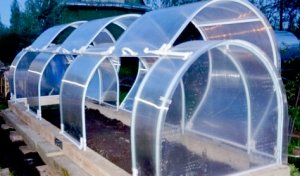
Greenhouses with an opening roof are placed where a small window is missing, plants need fresh air, otherwise there may not be a crop, your plantings will suffocate in the hot season. You can, however, limit yourself to two end doors. Opening front and rear walls will allow you to perfectly ventilate the room, insects will have access to the greenhouse for pollination, but in case of wind, your plantings may suffer, because you cannot be around all the time.
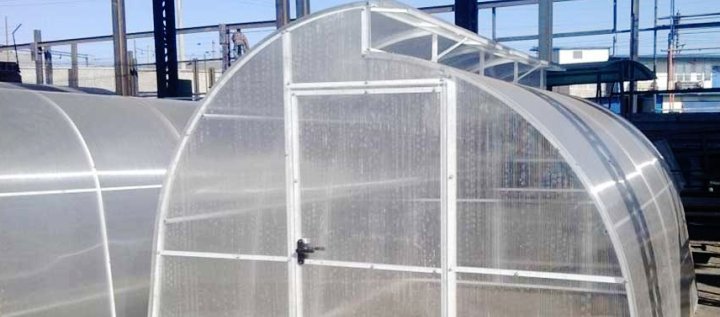
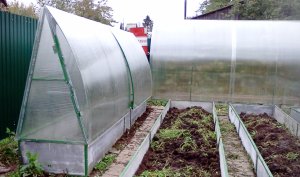
The most reasonable and solid buildings are greenhouses with an opening roof. Lightweight polycarbonate panels lean up or rise, as in the models of buildings "Cabriolet". To ventilate the greenhouses, such openings are quite enough, unexpected rain will not cause flooding, and the wind is not terrible for planting.
Transparent reliable polycarbonate, from which the walls and understandable panels are made, is an excellent durable material, with it your landings are not afraid of rain and hail. The only limitation in such greenhouses is the height, you can work comfortably with a roof height of at least two meters. The width of the building is also important, as practice shows, the length-width ratio should be a multiple of two meters, but it all depends on the capabilities of the summer cottage.
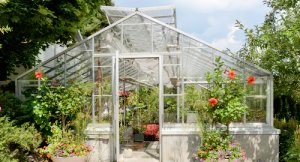
The stiffeners must be rigid and reliable; it is best to use metal structures with a cross section of at least 1.2 mm. For connection of structural elements are offered crab systems, they securely fasten both the structure itself and polycarbonate sheets.
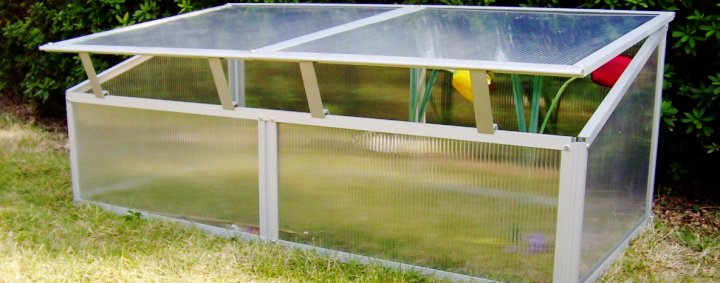
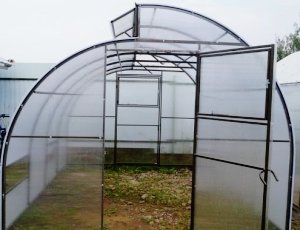
Ready-made greenhouses with sliding roofs are also very good. If in greenhouses familiar to summer residents the sheets are screwed to the frame, then in such models (for example, "Oasis") plastic panels slide easily along the rails. There are special latches so that you can open the ventilation openings in the desired position, it is not necessary to open the ventilation opening completely. The arched design of greenhouses is recognized as the most profitable. The advantages of such greenhouses:

A good owner can put such a greenhouse himself, quite it is not necessary to purchase ready-made expensive models. Polycarbonate sheets can be bought at building materials stores, choose the details of the frame yourself, you can limit yourself to the simplest and most affordable wooden structures.
Keep in mind that the tree is susceptible to decay, if you want your self-made greenhouse to stand for a long time, then the timber and boards must be treated with an antiseptic, the attachment points in the ground must be installed in roofing material or pipes (plastic or metal).
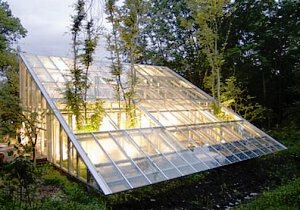
It is very easy to choose a design option - for your greenhouse with a removable roof find a bright spot. From lack of sunlight, plants will develop poorly or may die. Think about how you will remove the roof for the winter, it will be difficult to protect it from failure under heavy snow in winter, besides, inside the structure, the soil without a snow cushion will freeze very much, the soil will be desalinated.
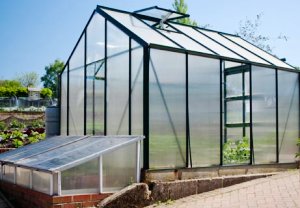
The biggest danger is wet heavy snow. Although the strength of polycarbonate is quite high, during thaws an ice crust will form on the surface of the sheets, and there is no need to talk about how ice destroys the most durable materials.
Further, about the time when the plants gain strength and begin to form an ovary. In an unventilated greenhouse, you won’t have to count on a good harvest.. Too hot indoor air sterilizes pollen, there are no insects in such rooms, even the most picky flies will look for cooler places where they can profit. Polycarbonate perfectly transmits the rays of the sun, but plants also need natural light. So the polycarbonate roof must be removed or moved.
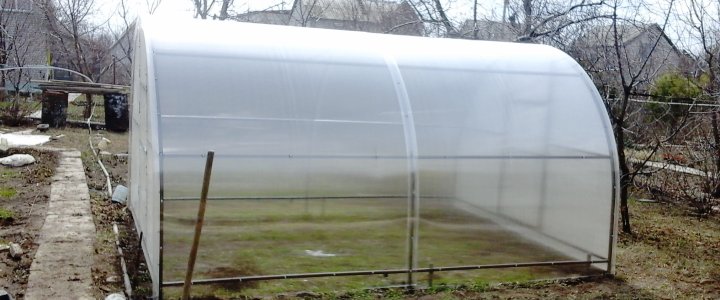
A greenhouse on the site is a necessary attribute for a modern gardener, everyone likes carefully grown fresh herbs in early spring, when it is still very expensive in stores. Vegetables from their garden on the table delight until late autumn, and all year round - jars of pickles in the underground.
Everyone knows that in order to obtain a high yield in a greenhouse, there must be a microclimate suitable for certain types of vegetables. In this regard, the owners have to spend a lot of time creating such an atmosphere - on a hot day, the greenhouse must be ventilated, in cool weather it is important not to forget to close the doors. And if there is no such possibility? Or memory failed?
Sometimes it happens that only open doors or vents are few, the temperature for fruit set is still high. In such cases, a sliding roof for a greenhouse will become an indispensable assistant, which will do everything for the owner - when necessary, it will open or close if necessary.
In the article we will talk about the types of retractable roofs, the advantages and disadvantages, and also tell you how you can make a simple construction of such a roof with your own hands.
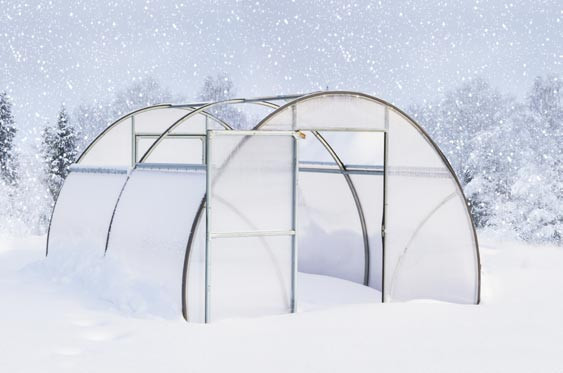
The advantages of a sliding greenhouse roof are obvious:
According to the method of opening the roof are divided into:
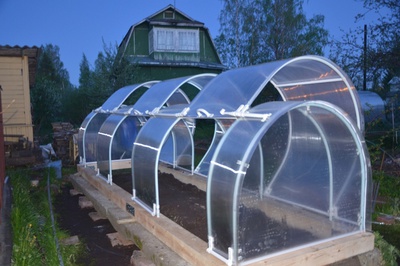
The first two types are installed on rails or skids, which are located along or across the structure. The third view is attached directly to the frame with one edge.
Important! The rail system can be installed at the bottom of the greenhouse, at the level of the foundation, another option is along the edge of the upper frame trim.
This construct depends on the location of the greenhouse:
I must say that arched and gable roofs are especially popular, such forms are most functional during operation, snow, water, dirt and fallen leaves do not accumulate on them.
In practice, a greenhouse with a retractable roof can be made of any material, only one will require a little time and effort, and the other will have to tinker with.
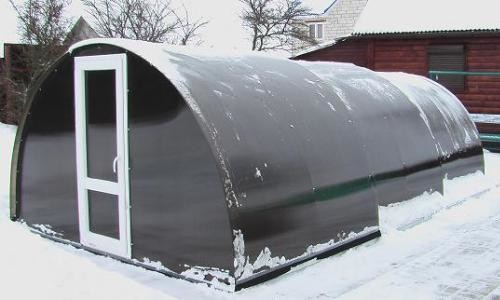
This:
A corner, a channel is perfect for a one- or two-pitched roof, a pipe or a metal profile of various sections is perfect for giving the roof an arched shape. The reliability and durability of this material allow you to use the greenhouse for more than a dozen seasons.
The most popular material for the manufacture of greenhouses (see), but making a sliding roof out of it is quite problematic. Movable elements require manufacturing precision, in order to give the wooden beam the necessary shape with your own hands, you need to have special equipment (machine, templates, clamps, etc.), and most importantly, knowledge of technology.
But if you order a wooden structure at a specialized enterprise, then a functional, aesthetic and durable greenhouse will appear on the site.
These materials are most often used for the manufacture of both the main frame of the greenhouse (see) and its moving elements. Plastic is easy to install, easy to bend, cut, drill.
The low weight of metal-plastic pipes facilitates transportation and installation of the structure. In addition, the cost of a greenhouse made of plastic elements will be an order of magnitude lower, and in terms of strength and durability, such a design will not yield to analogues from other materials.
Important! A do-it-yourself greenhouse with a sliding roof, with a metal-plastic frame and a polycarbonate coating, will be the pride of the owner, especially since this is a budget option with a minimum investment of effort and money.
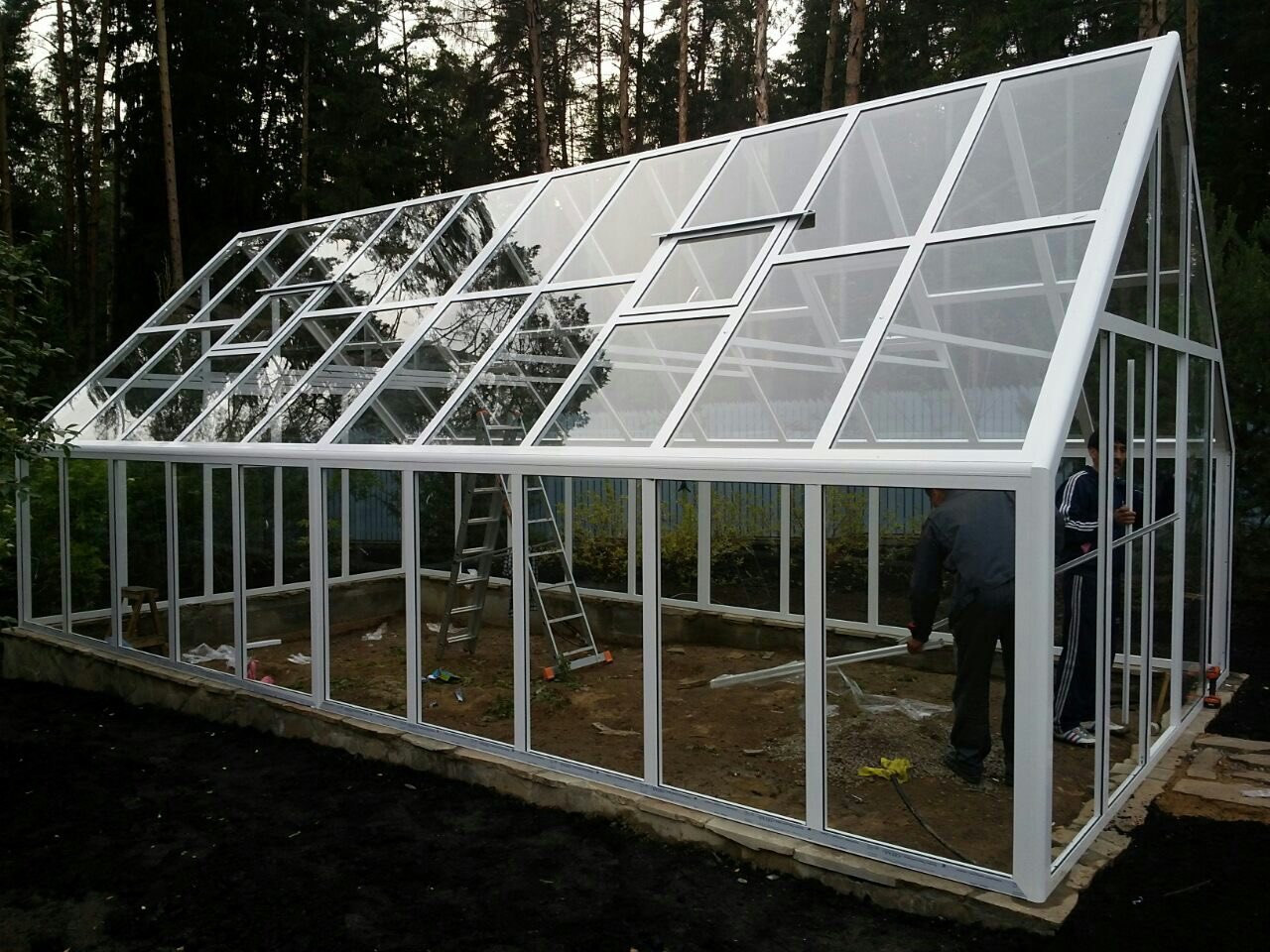
The following materials are used for glazing greenhouses:
It has absolute transparency and light transmission, but glass segments are heavy, require the installation of a solid foundation (see) and a solid frame. Working with this material is quite problematic, you need to have some skill in processing and installation.
According to gardeners, polycarbonate greenhouses with a sliding roof are the most optimal, convenient and functional option. The material has unique characteristics: it is flexible, can take an arched shape, is light, and can be processed perfectly. In addition, it gently diffuses the sun's rays, has high light transmission and good thermal insulation properties.
The material is similar in properties to polycarbonate, but slightly stronger. It is also easy to process and install, light and flexible; a greenhouse with such a coating does not need a massive foundation and heavy frame.
Sliding roofs are rarely made from them, since the materials have poor resistance to loads, mechanical damage, weathering, but these are the most inexpensive coatings. Such a greenhouse is enough for a season or two, then the material will need to be replaced. use roll materials mainly for frame folding structures.
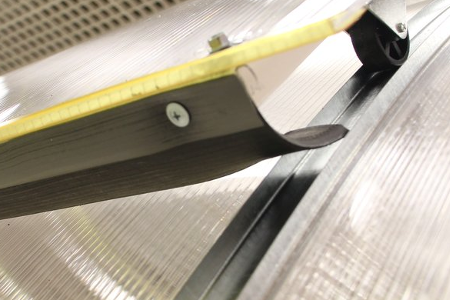
There are only two of them:
Well, everything is clear here, in this embodiment, the segments of the greenhouse are moved apart by the owner himself at the right time. For heavy structures, it is advisable to use winches, hoists and other manual mechanisms.
The sliding system is equipped with automation, which includes an electric drive, temperature sensors and relays. The owner sets the desired temperature, above which the device itself will open the structure, and when lowered, it will close.
There will be no need to constantly monitor the temperature in the greenhouse, spend time on airing and regulating the microclimate.

It is not difficult to make the simplest sliding roof with manual opening, consider the options for mounting a roof for a polycarbonate greenhouse.
This is the simplest version of a sliding roof, but it is quite possible to independently complete a fully sliding system.
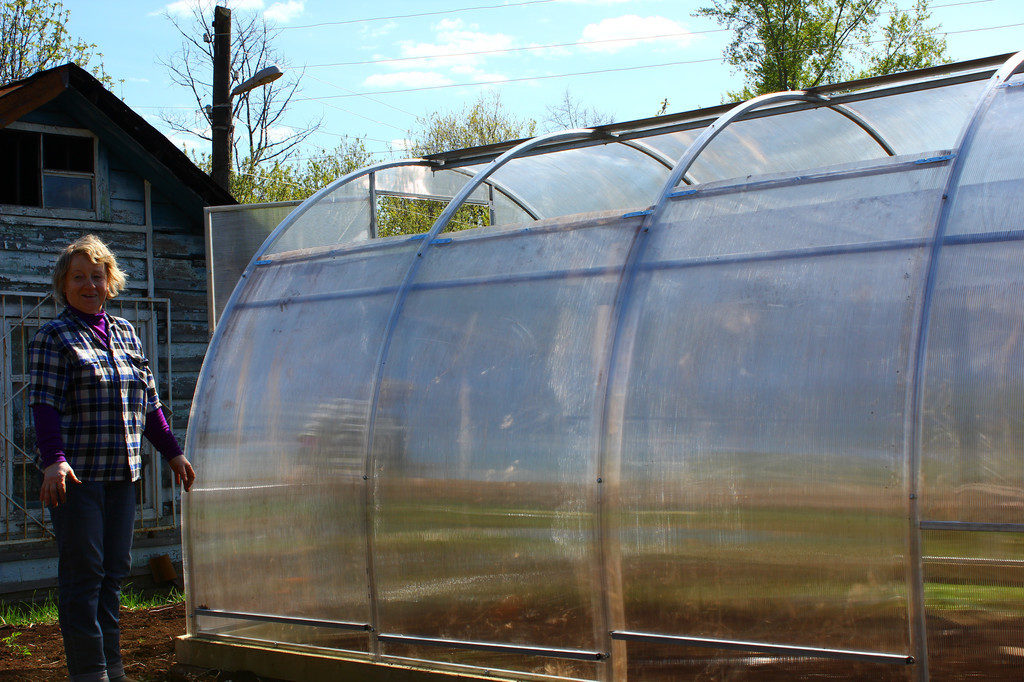
With a retractable roof, you can put it on skids, then the segments will diverge to the sides, running into each other and completely opening the desired area (like a “matryoshka” doll). In this case, the radius of the frame arcs should be different - the upper segments have more, and the lower ones, respectively, less.
Or, alternatively, the roof can slide down the transverse skids to one side or the other, exposing part of the greenhouse along its entire length.

Novosibirsk craftsmen came up with an efficient and functional greenhouse with a fully opening sliding roof, which fully justified itself in the conditions of the Siberian climate and after the "going out to the people" received a lot of rave reviews and such a soft and pleasant name "greenhouse Nurse Umnitsa with a sliding roof".
This light (50 kg), compact structure is assembled in 3-4 hours, the foundation for it is not needed, since the support posts are dug to a depth of 20 cm. cellular polycarbonate 4 mm thick.
Depending on the type, the frame is connected by welding or special plates (collapsible version).
In addition to the sliding roof, the greenhouse is equipped with a ventilation window, which opens with a hydraulic cylinder of a simple design: when the temperature inside the room rises, the oil, when heated, pushes out the piston, which in turn pushes the window frame. When the air inside cools, the piston is drawn into the cylinder and the window closes.
The width of the greenhouse is from 2 to 3 meters, and any length can be assembled, as it is possible to separately purchase two-meter segments. In other words, a nursery greenhouse with a retractable roof will suit any summer cottage, both small and large.

The roof is moved apart by a manual drive with such an easy move that even a child can scroll through it. Due to the arched shape and strong connection of the elements, the structure withstands significant snow and wind loads, sudden temperature changes and other negative atmospheric influences.
I must say that if such a greenhouse perfectly withstands the harsh Siberian winters, then in any other climate it will not be equal.
We talked about greenhouses with a retractable roof, we hope that you have found the information you need, and after watching the video in this article, you will draw the right conclusions and purchase or build a similar greenhouse with your own hands that will delight you with an excellent harvest.
The opportunity to get a larger harvest in the conditions of risky farming areas is appreciated not only by professional farmers, but also by those who grow various crops on their own plot for the needs of the family. The removable roof greenhouse provides good growing conditions for plants. Such a structure offers a lot of advantages to its owner. In addition, structures such as a drop-roof greenhouse can be built by one's own hands with a fairly low investment in finance, time and physical effort.
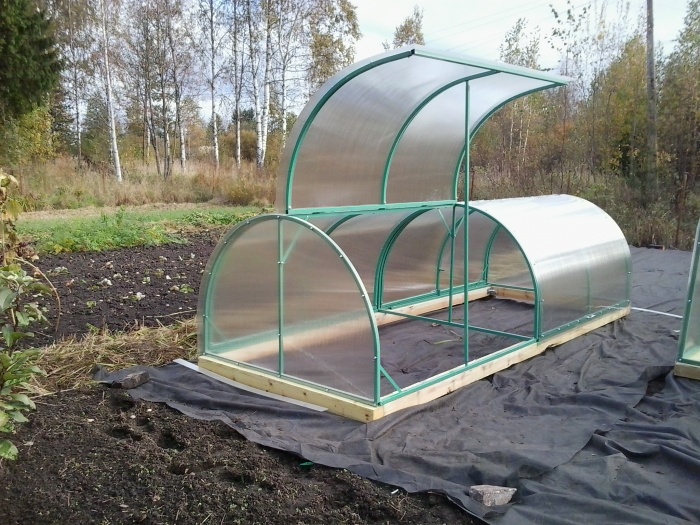
Structures, figuratively speaking, with variable geometry have common advantages. At the same time, positive qualities equally apply to any type of structure erected on a land plot.
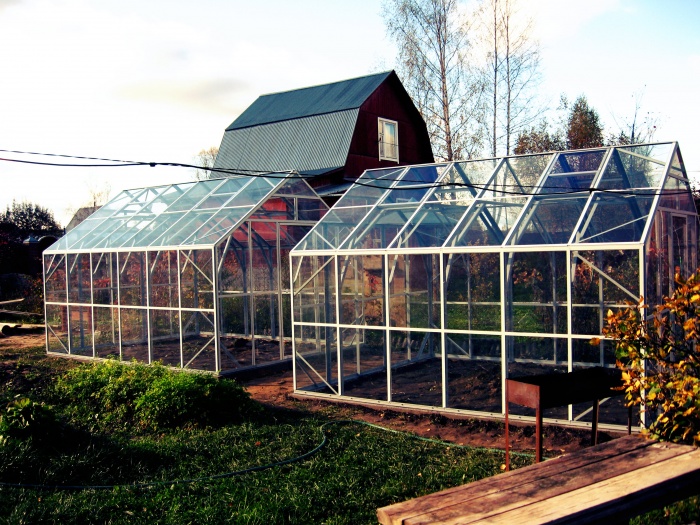
It can be either a greenhouse with a sliding roof, covered with glass as translucent panels, or a polycarbonate greenhouse with a removable roof, which in most cases is small in size and weight. The advantages include:
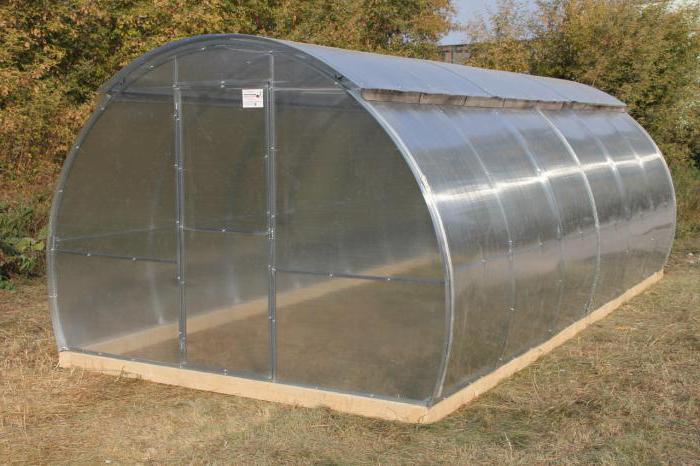
All these advantages have greenhouses of any design. However, if we talk about structures with a rigid structure, even if it provides for the possibility of ventilating the internal space, it is worth noting the list of disadvantages:
Structures with variable geometry are devoid of the above disadvantages. In particular, the sliding roof greenhouse has unlimited ventilation options, while the removable roof greenhouse allows plants to develop in their natural environment.
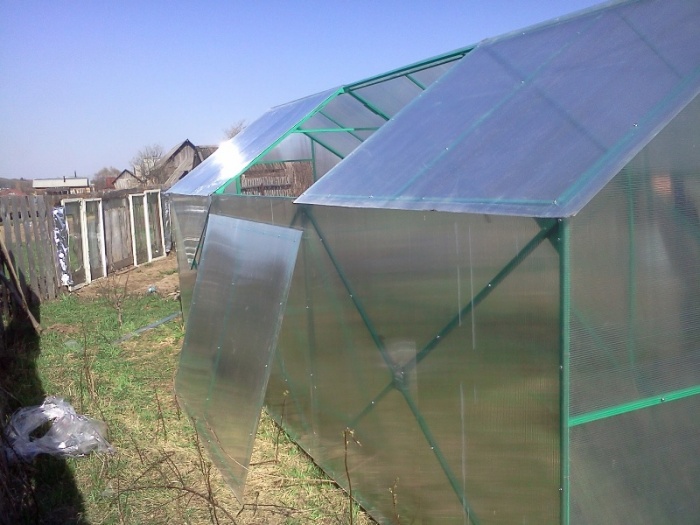
Note! Some of the disadvantages of variable geometry designs are easily overcome. For example, a greenhouse with a small arched roof does not allow all plants planted inside to develop equally if their height is large enough. The owner of the structure must think in advance at what height the roof should be located.
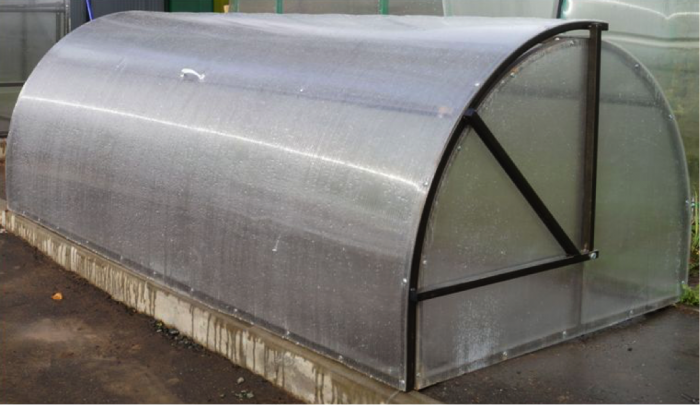
It is also worth considering what complexity and mass the roof of the greenhouse will be before starting construction. However, all the disadvantages of sliding, folding, sliding and sectional greenhouses are easily taken into account and neutralized at the design planning stage.
In terms of designing the power base of the greenhouse, which will then be sheathed with translucent materials or covered with a glazing system, the future owner of the greenhouse is not limited in any way. You can form the "skeleton" of the structure from:
Considering the level of investment of time, effort and money - the latter option for, for example, a retractable roof greenhouse - looks very attractive. Today on the market you can even buy ready-made kits for assembly, which are offered by many manufacturers. And if the task is to build a greenhouse according to your own dimensions of length, width, height and with the desired roof structure, it will not be difficult to purchase the required number of profiles and special connectors. After preparing the metal "blanks" of the required length, it will not be difficult to combine them into a single structure.
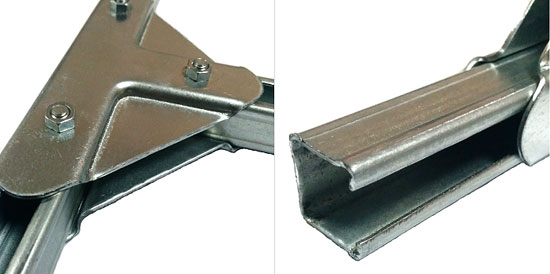
When constructing the base of a polycarbonate greenhouse with a removable roof, the choice of materials for the load-bearing frame is very wide. It can be either a wooden beam, parts of which are connected with screws and simple metal corners, or a thin-walled metal pipe, which is given the desired shape by cutting and bending.
If we consider the intricacies of using various types of roofs in greenhouses, we can conditionally divide them into three large groups:
One of the most complex are greenhouses with a sliding roof, which are a set of separate durable blocks that can move a long distance along rails laid on the soil surface. The most common variant of this design is arched modules, with which you can form a roof and a translucent surface area.
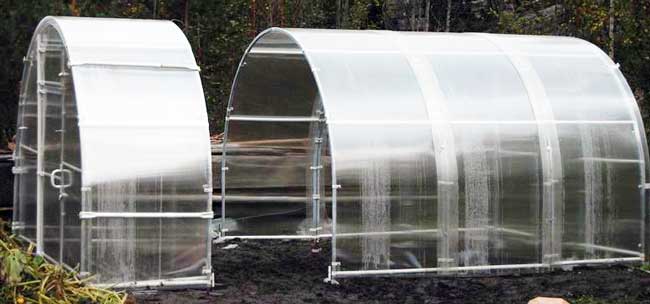
The choice of a rounded roof is determined purely by the criteria of rationality. Such a roof is durable and at the same time has a low weight. In addition, the construction of such a structure takes relatively little material.
Advice! If the greenhouse is built with your own hands, a shed or gable roof is often created. This option is optimal in terms of ease of formation, the absence of specially prepared curved elements. A wide range of translucent materials used for greenhouse cladding can also be used - from heavy glass to polycarbonate, and in some cases - polymer film.
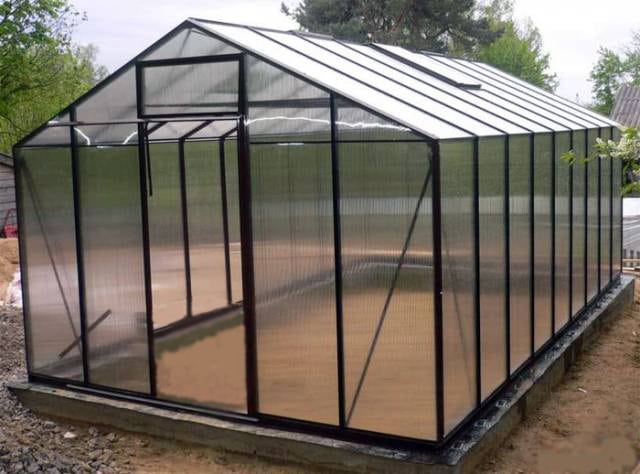
The simplest options found in household plots are a greenhouse with a folding roof or a removable roof. It can also be a small greenhouse for seedlings, of low height, consisting of separate modules. After the onset of optimal growing conditions for the plant, the greenhouse is actually removed entirely.
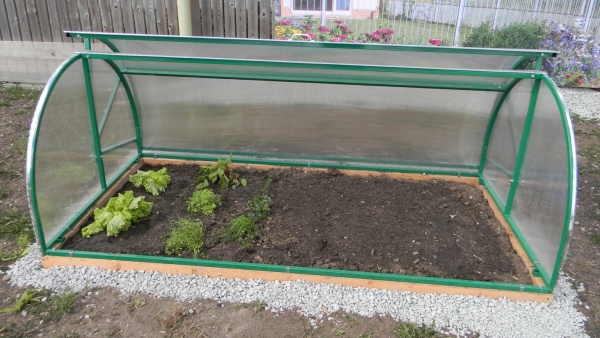
Comment! Higher and "large-scale" structures are based on the same principle, with the slight difference that when the warm season sets in, the owner removes only the roof or its individual segments. This version of the greenhouse can have any type of roof: arched, with one or two slopes.
A more complex option, which is used in a complex, stationary structure - removable roof blocks or folding elements. In the latter case, sections of the roof may provide for partial opening or complete reclining without complete removal.

Such a greenhouse is very simple in design and is often built by hand. As translucent materials (depending on the shape of the roof, the strength of the frame, the financial capabilities of the owner), film, polycarbonate, plastic for outdoor work, glass can be used.
The most preferred form that should be given to the roof is arched. Although this will require the manufacture of complex curved elements, the advantages of such a solution cannot be underestimated. The short list looks like this:
Here are a few examples illustrating the possibilities of greenhouses with a roof or arched sectors.
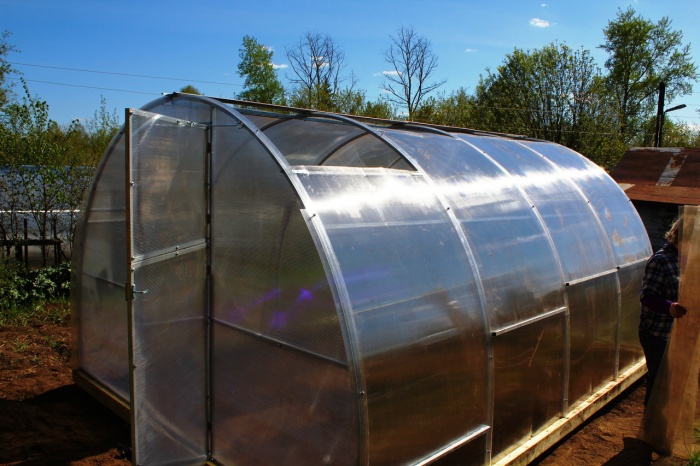
With this design, the roof sectors are shifted in the vertical direction, it is possible to create a different area of the open zone. This can be useful if several varieties of plants are grown within the same greenhouse, one of which, for example, is shown top irrigation, for which it is easy to use natural precipitation.
There can be several versions: with side opening sectors or with one central one, as shown in the video.

A small greenhouse may have a sliding folding roof, which partially opens when moving up. The same principle is used in more complex designs.
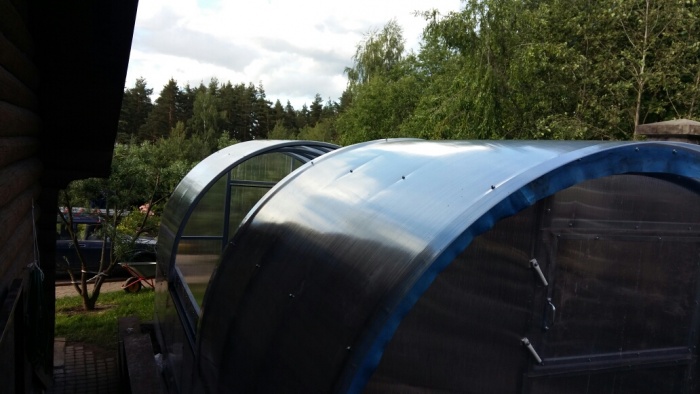
In the most complex version, the roof of the greenhouse is segmented. The modules can move both along guides installed on the soil surface, the foundation, and on a load-bearing frame, on the top of the walls.
Important! Recognizing complexity self-manufacturing curved elements, it is worth noting that on the market today there are a lot of offers from many suppliers, from which you can purchase both elements for the manufacture of roofing and complex high-rise segments.
Before erecting on your own personal plot greenhouse, it is worth carefully analyzing the possibilities. There is a wide range of offers on the market, both ready-made solutions of different sizes, and elements of various shapes for creating a power frame. In fact, with some skill in using the simplest tool and accuracy, anyone can build a greenhouse on their own land.
Dear gardeners! The company "Volya" is pleased to present you a novelty of 2015 - arched greenhouse with a sliding roof "Present".
Unlike other greenhouses from a pipe, in this sheet cellular polycarbonate they are not screwed to the frame, but are inserted into special plastic profiles along which they move up and down. Thus, the roof can be moved down on both sides independently of each other, and also fixed in the ajar position.
Thanks to the sliding roof, you get uniform ventilation along the entire length of the Present greenhouse, which is very important on hot summer days. In winter, the lack of a roof saves you from having to come to your dacha to clean the greenhouse from snow, which, moreover, getting inside, protects the top fertile soil layer from freezing.
The frame of the greenhouse is made of a profile pipe 33x33 mm. The absence of snow load made it possible not to install arc amplifiers. This had a positive effect on the final price of the greenhouse, and also simplified its assembly.
The dimensions of the greenhouse with a sliding roof remained classic for arched models: width - 3 meters, height - 2.2 m, length can be any, most importantly - a multiple of two meters.
Greenhouse "Present" is reliably protected from rust! The profile pipe used in the greenhouse was made directly at the Volya plant and differs from the others in a thicker layer of zinc and the absence of a weld. It is obtained by bending and joining galvanized sheet steel into a lock.
| Greenhouse "Present" - width 3 m / Length: | 4.16 m | 6.23 m | 8.3 m | 10.36 m |
| Frame price without polycarbonate | 29200 r | 37800 r | 46400 r | 55000 r |
| Price with thin polycarbonate STANDARD 4mm | 37400 r | 47900 r | 58400 r | 68400 r |
| Price with durable polycarbonate PREMIUM 4mm UV | 40900 r 39900 R |
53500 r 52000 R |
66200 r 64200 R |
78800 r 76300 R |
| Services and extras equipment | 4 meters | 6 meters | 8 meters | 10 meters |
| Service "Assembly and installation in the ground" ( |